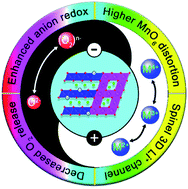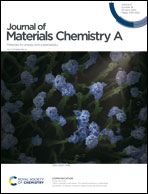The effect of oxygen vacancy and spinel phase integration on both anionic and cationic redox in Li-rich cathode materials†
Abstract
Tuning the anionic redox chemistry (O2− → O2n−) activity and reversibility by crystal and/or electronic modulation is essential for Li-rich oxide cathode materials. Herein, we report a facile strategy to improve the activity and reversibility of both anionic and cationic redox by integrating oxygen vacancies and the spinel phase. The initial specific capacity (216.1 mA h g−1vs. 316.3 mA h g−1), coulombic efficiency (80% vs. 94.8%), long-term cycling stability (1000 cycles at 5C) and voltage decay have all been greatly improved due to the largely suppressed irreversible oxygen release. The underlying modulation mechanism has been unraveled. Firstly, the introduction of oxygen vacancies decreases the covalency of TM–O and the density of states of the O 2p band, which mitigates the irreversible oxygen release during oxygen redox. Secondly, the spinel phase integration induced by oxygen vacancies not only improves the Li-ion conductivity and the rate capability due to its 3D Li+ channel and the expanded Li layer but also enhances the structural stability. Thirdly, the first-principles calculations indicate that the increase of delocalized electrons around the transition metal also intensifies the MnO6 octahedral distortion and the inactive Mn-ions are partially activated during the first cycle and participate in the charge compensation. This study sheds some new light on designing high-performance Li-rich layered oxide cathode materials by regulating the anionic and cationic redox with the incorporation of oxygen vacancies and the spinel phase.

- This article is part of the themed collection: Journal of Materials Chemistry A HOT Papers


 Please wait while we load your content...
Please wait while we load your content...